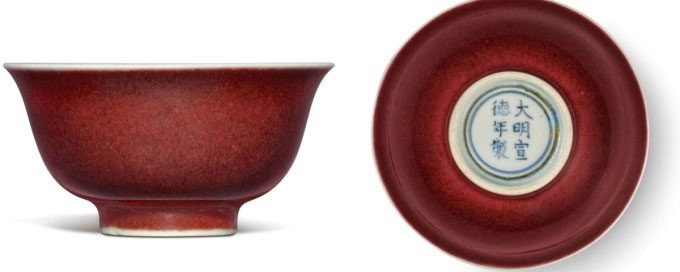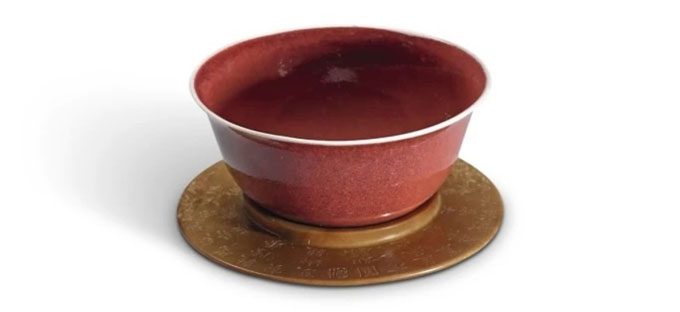The red glazed bowl from the reign of Ming Emperor Tuyen Tong, nearly 600 years ago, was sold for $1.9 million (44 billion VND).
The final price, including fees, was more than three times the initial estimate, set during the auction at Sotheby’s New York on March 21. The bowl measures 10.1 cm in diameter, and beneath its base are six blue characters glazed within a double circle.
The artifact is part of the T.Y. Chao (1912-1999) collection – a shipping magnate in Hong Kong and a renowned antique collector. The bowl was exhibited at the Hong Kong Museum of Art in 1978, as part of the T.Y. Chao Family Foundation’s collection of Ming and Qing dynasty porcelain.

Special red glazed bowl. (Photo: Sotheby’s)
According to Sotheby’s, monochrome red glaze is one of the greatest technical and aesthetic achievements of the Ming dynasty (1368-1644). The bright, deep red porcelain is compared to rubies and is extremely rare.
Experiments with monochrome red glaze began in kilns during the Yuan dynasty (1271-1368), but it wasn’t until the reigns of Ming Emperor Chengzu (1402-1424) and Ming Emperor Tuyen Tong (1425-1435) that it was perfected. Copper had to be intentionally added to the ceramic glaze to achieve the desired color. This material was used in small amounts, making it volatile during firing, thus creating a challenge in producing a uniform, sharp color. Artisans undertook extensive research, improving the basic glaze formula and altering the type of copper oxide used while reducing the quantity added.
A large quantity of red glazed porcelain was discarded and buried at the Jingdezhen kilns in Jiangxi, with only a few artifacts surviving. Experts believe this underscores the challenges artisans faced in producing these pieces.
The deep blood-red color is often considered “sacrificial red.” Therefore, ceremonial items during the Ming dynasty were primarily monochrome red porcelain. However, during the reign of Ming Emperor Tuyen Tong, there was no clear distinction in the court between items used for sacrificial offerings and those for everyday dining. As a result, the bowl could have been used on altars or dining tables.

The red bowl at the National Palace Museum in Taipei. (Photo: Sotheby’s).
The National Palace Museum in Taipei currently holds at least two red bowls of similar shape and size, one of which is a tea bowl. This bowl was later paired with a jade plate inscribed with a poem by Emperor Qianlong.





















































